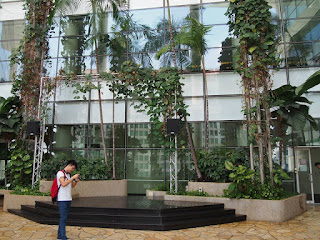National Library, Singapore
Image Source : https://www.bca.gov.sg/Awards/BestBuildableDesign/bda0612.html
The
National Library building was designed as an innovation architecture, which
incorporated bio climatic design techniques, advanced mechanical and electrical
engineering. National Library building is operating in an energy efficient way
by having several innovative green features. Thus, it is more sustainable environment
compare to other non-green feature building. The building uses the bio climatic
vegetation and landscaping to enhance the interior thermal environment.
Ventilation from the vegetation is one of the most fundamental components in the building. They provide a climatic relationship between the exterior and interior in the form of sun shading and provide a nice view of the exterior.
The vegetation act as a sun shading to the building.
In
addition, when there is sufficient natural light to illuminate the interior
spaces, a lighting control system which detected by the light sensors will turn
off the lighting. Singapore is a tropical climate country which is hot and humid
throughout the years. Therefore, the architect of the National Library building,
Ken Yeang, was trying to lower the local ambient temperature by utilizing the
extensive landscaping, sky terraces and roof gardens. There are 14 landscaped
gardens in the building and it contained 120 species of tropical plants. As a
result, these green spaces help to increase the energy efficiency and it
created more comfortable and cooling environment to the users.
Louvre sky court reduced direct sunlight into the building.
In conclusion, I think architects should virtually conceive the idea of green from inception to conception, while developers can take the opportunity to promote green building and marketing purposes. The intentions between the architects and developers must be clear in order to contribute to wider urbanity as well as the environment. The passive design features and materials used from construction to complete are important to improve the ecological balance between built and natural environment.
References:








Great blog. All posts have something to learn. Your work is very good and I appreciate you and hopping for some more informative posts. Architect in Thailand
ReplyDelete